Dive Brief:
- Demand for industrial real estate continues to outpace supply, with U.S. vacancy rates hitting a record low of 4.5% in Q2, according to new Cushman & Wakefield research.
- Rental rates are climbing alongside demand throughout the U.S. The asking rent for industrial space increased 6.8% YoY, driven by Class A space around major cities and ports.
- "We are really not seeing an end in sight for that rental rate growth," said Carolyn Salzer, Cushman & Wakefield's head of logistics and industrial research for the Americas. "It's really picked up."
Dive Insight:
Companies are scrambling to land warehouse and distribution space to hold inventory and fulfill online orders, leading to low vacancy rates nationwide. Those with a large digital sales presence — Amazon, Walmart, Wayfair and Chewy among them — and third-party logistics providers are driving demand, Salzer said.
Amazon is spending heavily to build out its logistics infrastructure as it aims to return its one-day delivery offering to pre-pandemic service levels. Chewy, the online pet retailer, is adding new warehouse locations and upgrading existing ones to improve cycle times and reduce fulfillment costs, executives said in March.
E-commerce represented 25% of logistics real estate giant Prologis' new lease signings in Q1. A recent CBRE report said the U.S. must add 330 million square feet of e-commerce warehouse space by 2025 to keep pace with industry growth.
"We didn't necessarily know if they could maintain the same pace as they did throughout the first half of this year, and they really did," Salzer said of online retailers.
The growth in e-commerce accelerated once the COVID-19 pandemic gripped the U.S., and rising rents haven't deterred companies from snapping up warehouse space needed to fulfill orders. Asking rent rates for warehousing and distribution real estate landed at $6.42 per square foot in Q2, which Salzer said is up 5.5% YoY. The actual rent is likely higher.
"A lot of these projects are coming in as subject to offer or negotiable, and if anything, the landlords can drive the rates up," she said.
Rents rise in each region of the U.S.
Some companies are being less picky about their real estate in today's competitive marketplace. A facility deemed a weak fit for e-commerce a few years ago may now be attractive if it's within last-mile delivery range, Salzer said.
"They'll scoop that up because [inventory is] just there for a day or two as they're trying to pump out product to get to the customer," she said.
Others are choosing to be flexible in warehouse location as they find it difficult to secure affordable space in high-density urban or port-proximate markets, Salzer said. In the West, this means avoiding expensive markets such as Los Angeles and San Diego. Phoenix is growing in popularity as a nearby alternative.
The West region's asking rent was $10.39 per square foot in Q2, while Phoenix's was $7.96, according to Cushman & Wakefield. Still, asking rental rates are climbing and vacancy rates are falling in Phoenix, too.
"It's a little bit of a cheaper option but still only four hours away from the coast and also closer to the rest of the U.S.," Salzer said of Phoenix.
The South, meanwhile, had the highest vacancy rates at 5.4%. Demand in the region has "room to run," she added, with Dallas-Ft. Worth and Atlanta seeing strong construction pipelines.
Square footage under construction in the U.S. hit 476 million in Q2, up 46.9% YoY, according to Cushman & Wakefield. More than one-third of that space will be gobbled up quickly, however, with 37% entering the market as built-to-suit. Salzman said rental rates are climbing without a clear end point, but she expects the vacancy rate will bump up to 5% by year's end thanks to the large construction pipeline in place.














